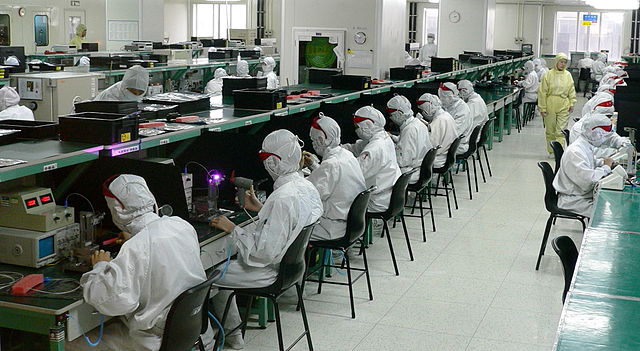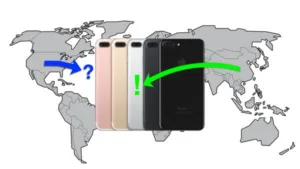If you haven’t heard about the USA elections you must be living on a different planet. Since the election is now over, it’s time to look at the aftermath of a very interesting campaign. I will not discuss anything political, but look at the consequences for the Consumer Electronics industry and the display industry in particular.
One of the topics during the election season was that the now President Elect of the USA will put pressure on the CE industry and Apple in particular to start making their iPhones and the computers in the USA instead of China. In recent days, this topic has made the headlines of many newspapers on both sides of the political divide as well as outside the US.
This idea was actually floated by several candidates on both sides and follows a discussion between the current President, Obama, and the Apple CEO, Steve Jobs. Back then, Steve Jobs told the President “these jobs are not coming back” (Herald Tribune, 2012). And so far this prophecy was absolutely correct. As a kind of “consolation prize” to President Obama, Apple did bring back some of the assembly of Mac computers.
However, the current situation is a little bit more tricky. The President Elect has said several times that he will use duties to make ‘USA made’ products more competitive. Several articles are taking exception to the fact that a duty rate on Chinese products would lead to CE companies moving to other countries, which would actually benefit them. For example labor rates in Vietnam are much cheaper than in China (around 40% less). It would still not force companies to make anything in the USA.
There is however another side to the story. The USA has lost many manufacturing jobs to China based on a more cost effective business model of producing in China. This model is based on a direct comparison of loaded labor rates between the countries. This way of thinking puts the USA out of contention for most manufacturing jobs and reiterates Steve Jobs words to President Obama. If the discussion between Tim Cook and Donald Trump follows the same path, the result is pretty much predictable. Apple will start assembling the iPod in the USA until it finally gets pulled from the market.
But what would the effect be on the iPhone, the cornerstone of Apple’s market power? According to IHS, the actual manufacturing cost to make an iPhone 7 with 32GB is about $225. A whopping $5 of this total is the assembly and testing cost per unit. The rest is all components. Transferring the manufacturing to the US might quadruple the assembly and testing cost to $20, which would bring the cost $240. To be cost neutral to the consumer, Apple would lose $300 million in profit per year, give or take some millions of course. No company in the world would do this in order to satisfy any politician.
Built by Robots
However, here is the catch. This estimate only makes sense if we transfer the jobs as they are from China to the USA on a 1 to 1 basis. Does this even make sense? According to the BBC, earlier this year, Foxconn replaced 60,000 workers with robots. This suggests that Foxconn believes that a robot can assemble a CE device for less money than a factory worker. The article explains that this reduction of the assembly jobs equated to more than 50% of the work force. As a rough estimate we could say that today over 50% of the iPhone assembly is done by a robot already. The question if we could move manufacturing from China to the USA changes into the question if a robot will work the same way in the USA as it does in China. The answer to that question seems to be much easier to comprehend.
 This electronics factory in Shenzhen image may be of historic interest now – photo by Jurvetson (flickr)
This electronics factory in Shenzhen image may be of historic interest now – photo by Jurvetson (flickr)
As a consequence, the incoming USA President might get his wish of making iPhones in the USA again, however it would not equate to as many jobs as he may have envisioned. The latest news regarding Apple investigating this possibility included their two assemblers Foxconn and Pegatron to investigate the possibility to manufacture in the USA. Pegatron said ‘thank you, but no thank you’, while Foxconn is proceeding with the plan. Remember Foxconn was the one that uses the robots.
This development is certainly being watched by many countries around the world with large interest. Why would Apple produce iPhones in the USA and then ship them to Europe and Asia? Wouldn’t it make more sense to have a distributed manufacturing system where several plants around the world manufacture could respond to regional demand? Well, maybe this is just a little bit of optimistic thinking right now. (although this already happens in the TV market, where shipping cost is a much bigger factor – Man. Ed.)
What About the Supply Chain?
So, if moving an assembly line becomes a possibility, what about the component suppliers. Would it mean that the displays will be made next door in the USA as well? As it stands right now, this is not a viable option based on the massive capital investments in semiconductor and display factories in Asia at the moment. From recent history we know that these kind of investments are often, or always, driven by government backing and involvement. Such backing is less likely in the US business environment and therefore less likely to succeed than in Asian countries. However, today we are shipping iPhones around the globe, so we could still ship display panels instead.
What is left is the question of a labor pool to support any of such massive changes. The USA engineering pool is heavily skewed towards design engineering. Manufacturing engineering has been contracting for decades. So, where would the US get these talents from? Of course immigration is an option to help fix this particular issue. Apple has long pushed the US government to make it easier to bring in talent on temporary visa. But that would further decrease the net influx of jobs to the USA until there are more manufacturing engineers available?
So is the iPhone – “Made in the USA” – just a day dream of politicians or is it real? Considering the options, I see a realistic chance of change in the CE industry coming our way. It would not bring back any jobs lost, rather it creates a new type of job closer to a CAD CAM or CNC operator rather than a assembly line worker. The real question is what are we doing with the net loss of jobs on a world wide basis. – Norbert Hildebrand

